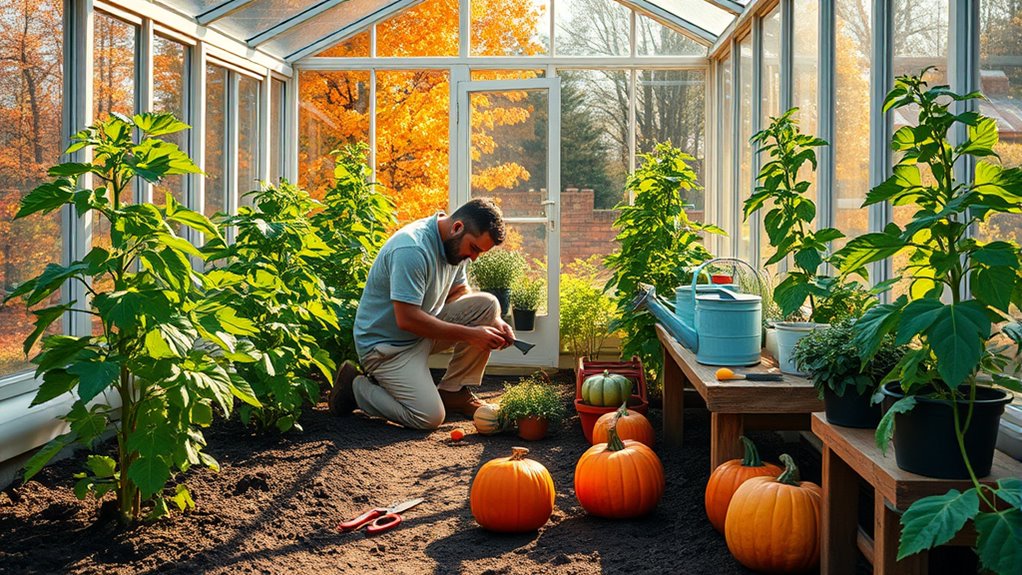To keep your greenhouse thriving, focus on seasonal maintenance tasks. In winter, install heating systems and boost thermal mass. Spring's about cleaning, organizing, and preparing soil. In summer, prioritize ventilation and pest checks. Come fall, inspect for damage and clean your irrigation system. Regularly declutter and sanitize to prevent disease buildup. Staying on top of these tasks will lead to healthier plants and a more efficient greenhouse. There's much more to explore for each season!
Key Takeaways
- Conduct thorough cleaning of the greenhouse each season, removing debris and sanitizing surfaces to prevent disease buildup.
- Inspect and maintain heating, cooling, and ventilation systems to ensure optimal climate control throughout the year.
- Regularly check and clean irrigation systems to guarantee consistent water distribution and prevent blockages.
- Assess and amend soil by clearing old roots, adding compost, and testing pH levels for healthy plant growth.
- Monitor plants for pests and diseases, ensuring good air circulation and prompt removal of any affected specimens.
Winter Maintenance Strategies
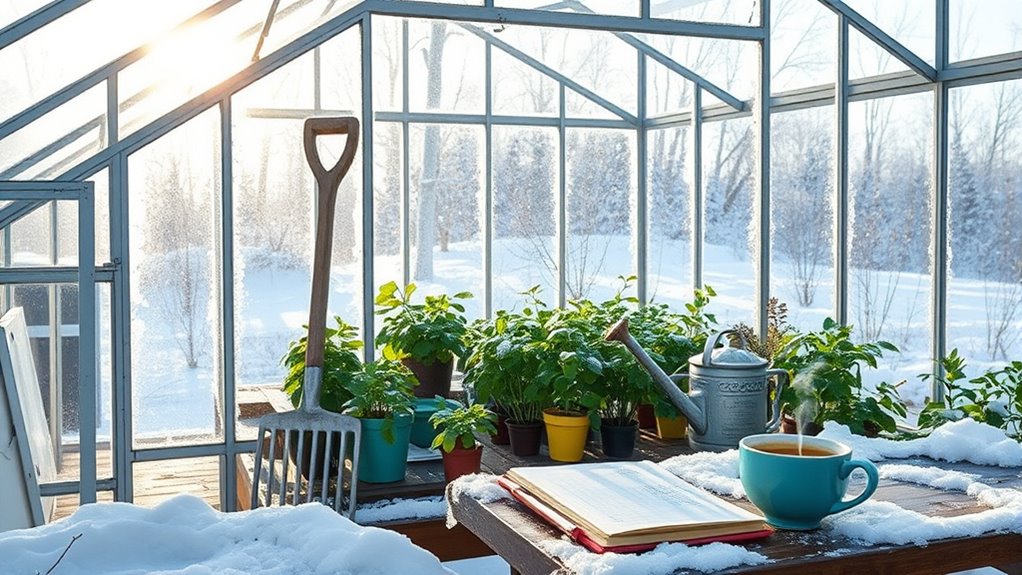
As winter sets in, maintaining your greenhouse becomes essential to keeping your plants healthy and thriving.
Start by installing heating systems like electric or propane heaters, or consider passive solar methods for warmth. Boost thermal mass with water barrels or bricks to store heat during the day. Use germination mats to keep seedlings cozy and thermal blankets on cold nights for extra protection.
Ensure proper ventilation to prevent humidity buildup; oscillating fans can improve airflow.
Adjust your watering schedule since plants need less moisture in winter—monitor soil moisture to avoid overwatering.
Finally, keep your greenhouse clean by removing debris and inspecting for pests regularly. These strategies will help your plants flourish despite the cold.
Spring Preparation Essentials
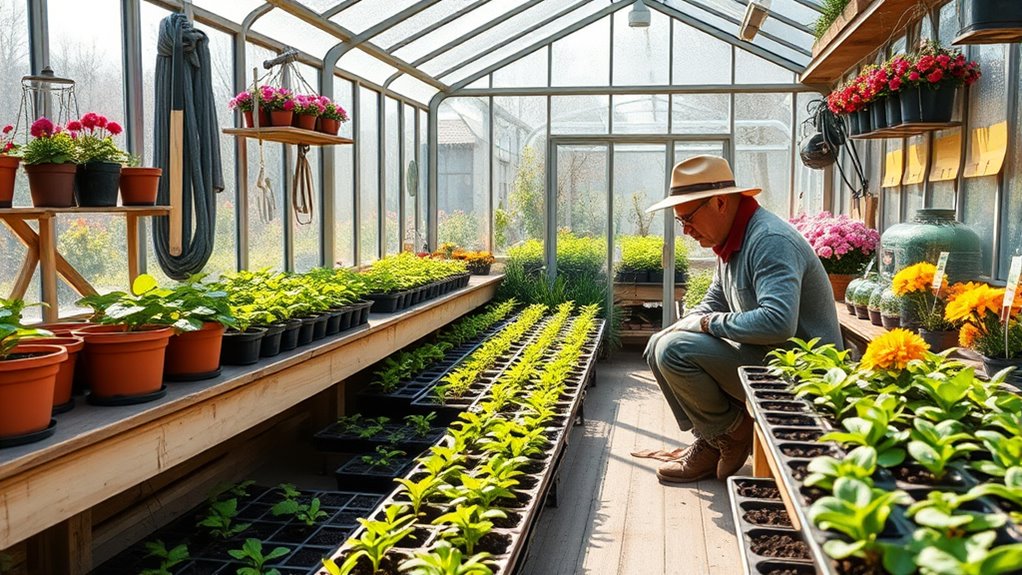
Spring marks a critical time for greenhouse enthusiasts, as preparing your space can set the stage for a successful growing season.
Start by cleaning and organizing your greenhouse; remove clutter and debris to prevent pest habitats. Wash surfaces with mild soap to maximize sunlight exposure, and sterilize tools and pots with a bleach solution.
Next, optimize your heating and cooling systems, enhancing ventilation for fresh airflow. Inspect your irrigation system for consistent water distribution and test seals on doors and windows for insulation.
Don't forget soil preparation—clear old roots, amend with compost, and test pH levels.
Finally, restock seeds and essential supplies, ensuring everything's labeled and organized for easy access during planting.
Summer Care Practices
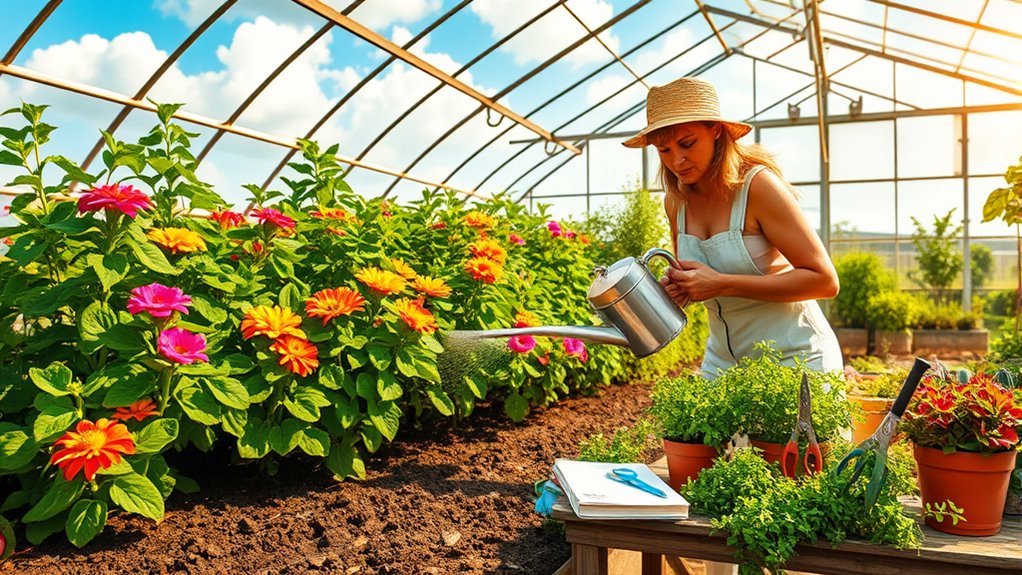
To guarantee your greenhouse thrives during the summer months, it's essential to adopt effective care practices that cater to the unique challenges of the season.
Start by cleaning and decluttering; remove old plants and debris for a fresh environment.
Verify your ventilation systems, including vents and fans, are functioning well to keep temperatures between 70-85°F.
Regularly inspect for pests, and refresh your soil with compost or fertilizers.
Implement drip irrigation for efficient watering, establishing a consistent schedule, preferably in the early morning.
Choose heat-loving plants like tomatoes and peppers, and prune them to enhance airflow.
Finally, maintain your greenhouse's structure by sealing gaps and verifying equipment is calibrated for peak performance. Additionally, consider incorporating greenhouse plants that are well-suited for your climate to maximize your growing potential.
Fall Maintenance Checklist
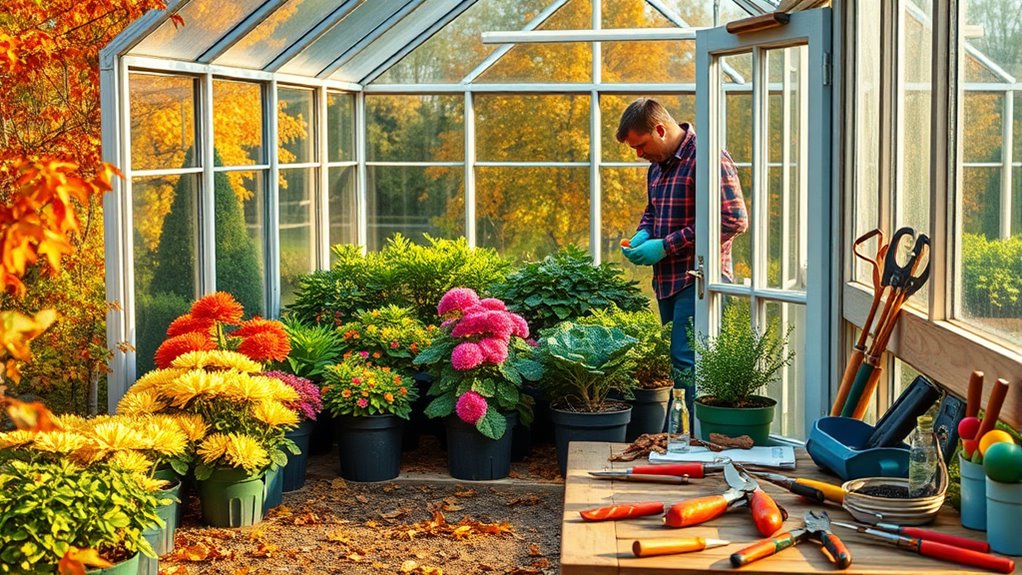
After the heat of summer, it's time to prepare your greenhouse for the cooler months ahead. Start by examining the structure for any deterioration, checking glazing for cracks or punctures. Make sure your gutters are clear and free from rust, and verify that vents operate smoothly.
Next, focus on your environmental control systems. Clean your heating system, inspect cooling fans, and calibrate sensors. Don't forget to check seals on energy curtains and test backup generators.
For your irrigation system, assess fluid flow, clean filters, and flush the fertigation system. Regularly inspect plants for pests and diseases, ensuring good air circulation. Additionally, consider using safety gear like gloves and goggles when handling chemicals or cleaning equipment.
Finally, clear debris, repair damaged equipment, and take inventory of supplies for the next season.
General Cleaning and Maintenance Tips
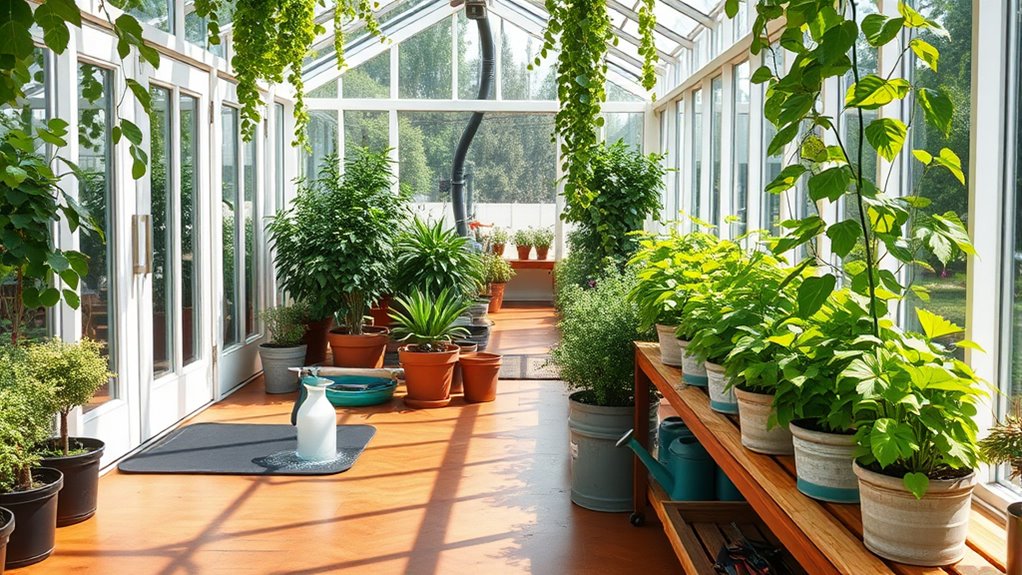
Maintaining a clean and organized greenhouse is essential for promoting plant health and preventing pests and diseases. Start by removing all plants and equipment for a thorough interior cleaning. Keeping the greenhouse tidy not only benefits the plants but also allows for better access to tools and supplies. Additionally, regular cleaning of surfaces helps to minimize the risk of fungal infections.
Clear debris from gutters and clean the panels to enhance light transmission. Use non-toxic disinfectants to sanitize surfaces and prevent disease buildup.
Regularly inspect for pests, removing any diseased plants immediately. Keep vents and fans dust-free to guarantee proper ventilation.
Scrub the floors with warm water and a stiff brush to eliminate dirt. Maintain your tools by cleaning and disinfecting them regularly, and check for gaps or cracks in the structure to keep pests out. Additionally, ensuring proper ventilation control is crucial for maintaining a healthy environment for your plants.
Stay proactive to create a healthy environment for your plants.
Seasonal Preparation and Repairs
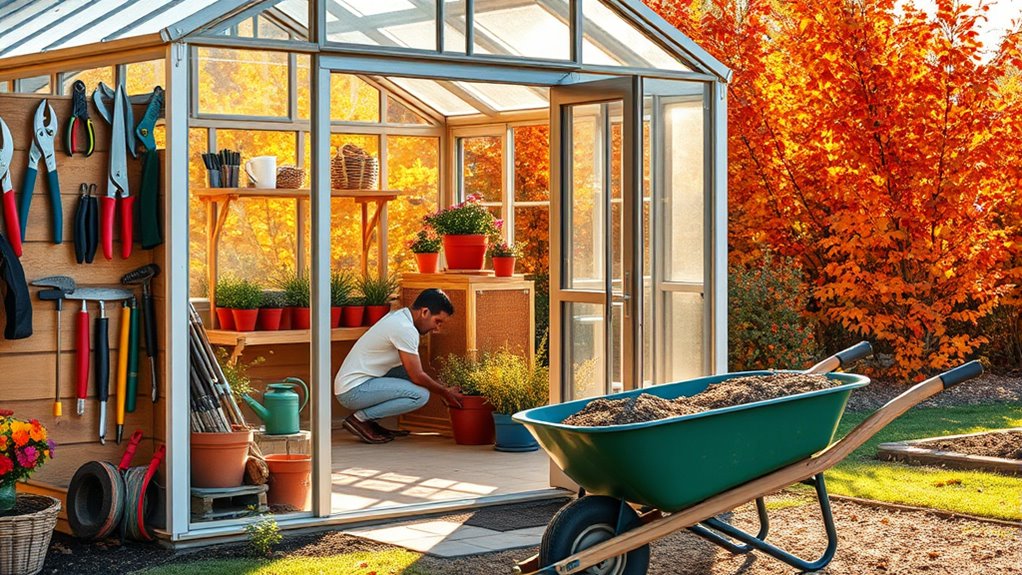
As the seasons change, preparing your greenhouse becomes essential to guarantee ideal growth and plant health.
In spring, set up your shelving, benches, and potting areas for the growing season ahead.
As summer arrives, install shade cloths to manage sunlight and keep your plants cool.
When fall comes, remove summer crops, then clean and disinfect the greenhouse to prevent pests and diseases.
In winter, make certain your heating systems are functioning properly and prepare for seed starting.
Throughout the year, regularly inspect greenhouse structures for damage, and check your equipment, including irrigation systems and fans, to keep everything running smoothly.
Staying proactive with these seasonal preparations and repairs guarantees a thriving greenhouse environment.
Inventory Management for Your Greenhouse

How can effective inventory management transform your greenhouse operations? By accurately tracking inventory levels, you can guarantee timely restocking and avoid stockouts.
Regular audits help maintain precise data, while analyzing historical sales allows you to forecast demand effectively. Building strong supplier relationships guarantees you receive high-quality products on time.
Regular audits and historical sales analysis are key to accurate demand forecasting and maintaining strong supplier relationships for timely, quality products.
Utilizing inventory software, like nursery management tools and barcode systems, streamlines tracking and automates reordering. Implementing strategies such as FIFO maintains product freshness, and bulk ordering leverages volume discounts.
Training your staff in best practices to enhance efficiency, and regularly monitoring stock to address shortages are crucial steps in maintaining operations. Additionally, understanding water sources is vital when planning for greenhouse irrigation systems. With these techniques, you'll optimize resources, reduce waste, and ultimately boost your greenhouse's profitability and sustainability.
Frequently Asked Questions
How Often Should I Perform Soil Testing in My Greenhouse?
You should perform soil testing in your greenhouse regularly to guarantee ideal plant growth.
If you're growing high-value crops, aim for annual tests. For sandy soils, test every two to three years, while clay soils can be tested every three to four years.
Consistent sampling times will help reduce variability and give you accurate results.
What Types of Organic Fertilizers Are Best for Greenhouse Plants?
When it comes to nurturing your greenhouse plants, think of organic fertilizers as gentle friends that enrich the soil.
You'll find compost, manure, and worm castings work wonders for long-term health. Fast-acting options like blood meal can give your leafy greens a boost.
For balanced nutrition, consider Nature's Source 3-1-1 or Sustane 8-4-4. Mixing these can guarantee your plants thrive, making your greenhouse a vibrant oasis.
How Do I Identify Common Pests in My Greenhouse?
To identify common pests in your greenhouse, look for specific signs.
Check for small, soft-bodied aphids on new leaves or curled leaves. Notice tiny flies hovering near the soil, indicating fungus gnats.
Spot white, cottony patches for mealybugs, or fine webbing and stippled leaves for mites. Inspect for mottled leaves that suggest thrips.
Regular monitoring helps you catch infestations early, ensuring your plants stay healthy and thriving.
What Tools Are Essential for Greenhouse Maintenance Year-Round?
For year-round greenhouse maintenance, you'll need a variety of essential tools.
Start with trowels and hand forks for soil handling, and don't forget pruning shears for trimming.
Gloves protect your hands, while markers help you track plant care.
For watering, keep garden hoses and watering cans handy.
Thermometers and hygrometers guarantee ideal conditions.
Finally, have gutter cleaning tools ready to prevent water accumulation.
These tools will keep your greenhouse thriving!
When Is the Best Time to Order Seeds for My Greenhouse?
Picture your greenhouse filled with vibrant blooms and fresh produce. To achieve this, you should order seeds in late winter to early spring.
This timing guarantees your seeds arrive before planting season. Keep an eye out for seed catalogs in December, and don't hesitate to grab popular varieties early to avoid backorders.
Plan your budget wisely, and make certain you choose seeds that will thrive in your greenhouse environment.
Happy planting!
Conclusion
As you move through the seasons, your greenhouse transforms just like nature outside. Embrace winter's quietude with maintenance that preps your haven for spring's vibrant awakening. Feel the warmth of summer sun as you nurture your plants, and savor the crisp air of fall while tending to your space. With each task, you're not just caring for your greenhouse; you're weaving a tapestry of growth and life, ensuring your little slice of paradise thrives all year round.
